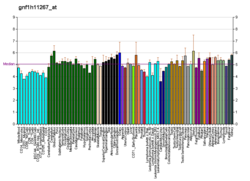Protein-coding gene in the species Homo sapiens
| OR2AE1 |
|---|
|
| Identifiers |
|---|
| Aliases | OR2AE1, OR2AE2, olfactory receptor family 2 subfamily AE member 1 |
|---|
| External IDs | HomoloGene: 128272; GeneCards: OR2AE1; OMA:OR2AE1 - orthologs |
|---|
| Gene location (Human) |
|---|
 | | Chr. | Chromosome 7 (human)[1] |
|---|
| | Band | 7q22.1 | Start | 99,876,062 bp[1] |
|---|
| End | 99,877,033 bp[1] |
|---|
|
| RNA expression pattern |
|---|
| Bgee | | Human | Mouse (ortholog) |
|---|
| Top expressed in | - right coronary artery
- skeletal muscle tissue
- duodenum
- gastric mucosa
- muscle of leg
- triceps surae
- gastrocnemius muscle
- islet of Langerhans
- prefrontal cortex
- anterior pituitary
|
| | | More reference expression data |
|
|---|
| BioGPS |  | | More reference expression data |
|
|---|
|
| Gene ontology |
|---|
| Molecular function | - G protein-coupled receptor activity
- olfactory receptor activity
- signal transducer activity
| | Cellular component | - integral component of membrane
- plasma membrane
- membrane
| | Biological process | - sensory perception of smell
- signal transduction
- response to stimulus
- detection of chemical stimulus involved in sensory perception of smell
- G protein-coupled receptor signaling pathway
| | Sources:Amigo / QuickGO |
|
| Orthologs |
|---|
| Species | Human | Mouse |
|---|
| Entrez | | |
|---|
| Ensembl | | |
|---|
| UniProt | | |
|---|
| RefSeq (mRNA) | | |
|---|
| RefSeq (protein) | | |
|---|
| Location (UCSC) | Chr 7: 99.88 – 99.88 Mb | n/a |
|---|
| PubMed search | [2] | n/a |
|---|
|
| Wikidata |
|
Olfactory receptor 2AE1 is a protein that in humans is encoded by the OR2AE1 gene.[3]
Olfactory receptors interact with odorant molecules in the nose, to initiate a neuronal response that triggers the perception of a smell. The olfactory receptor proteins are members of a large family of G-protein-coupled receptors (GPCR) arising from single coding-exon genes. Olfactory receptors share a 7-transmembrane domain structure with many neurotransmitter and hormone receptors and are responsible for the recognition and G protein-mediated transduction of odorant signals. The olfactory receptor gene family is the largest in the genome. The nomenclature assigned to the olfactory receptor genes and proteins for this organism is independent of other organisms.[3]
See also
References
- ^ a b c GRCh38: Ensembl release 89: ENSG00000244623 – Ensembl, May 2017
- ^ "Human PubMed Reference:". National Center for Biotechnology Information, U.S. National Library of Medicine.
- ^ a b "Entrez Gene: OR2AE1 olfactory receptor, family 2, subfamily AE, member 1".
Further reading
- Sanger Centre T, Washington University Genome Sequencing Cente T (1999). "Toward a complete human genome sequence". Genome Res. 8 (11): 1097–108. doi:10.1101/gr.8.11.1097. PMID 9847074.
- Thompson EE, Kuttab-Boulos H, Yang L, et al. (2006). "Sequence diversity and haplotype structure at the human CYP3A cluster". Pharmacogenomics J. 6 (2): 105–14. doi:10.1038/sj.tpj.6500347. PMID 16314882. S2CID 10102745.
External links
This article incorporates text from the United States National Library of Medicine, which is in the public domain.
Class I
(fish-like receptors) | | Family 51 | |
|---|
| Family 52 | |
|---|
| Family 56 | |
|---|
|
|---|
Class II
(tetrapod specific receptors) | | Family 1 | |
|---|
| Family 2 | |
|---|
| Family 3 | |
|---|
| Family 4 | |
|---|
| Family 5 | |
|---|
| Family 6 | |
|---|
| Family 7 | |
|---|
| Family 8 | |
|---|
| Family 9 | |
|---|
| Family 10 | |
|---|
| Family 11 | |
|---|
| Family 12 | |
|---|
| Family 13 | |
|---|
|
|---|
















